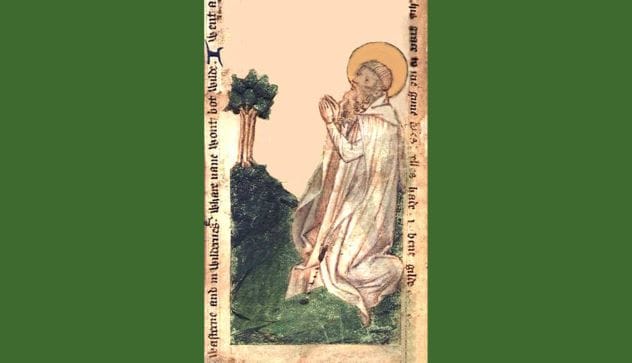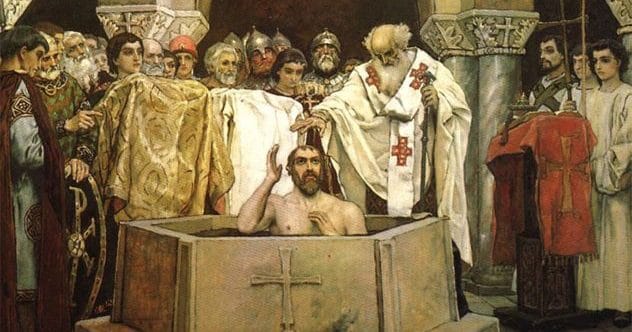When we hear the word “saint,” we often think of holy men and women known for their mercy, kindness, and temperance. While many saints fit this description, some led lives that were, shall we say, a bit more colorful. History is filled with individuals beatified despite behavior that was, at times, downright scandalous. These stories offer hope to even the most troubled among us.
Here are ten saints who lived extraordinarily unsaintly lives.
St. Augustine of Hippo (AD 354–450)
St. Augustine of Hippo is one of Christianity’s most influential figures. His theological masterpiece, Confessions, remains a cornerstone of religious philosophy. Yet, what exactly was he confessing? Augustine, born in North Africa, excelled in his studies but admitted to stealing fruit from a neighbor’s garden—not for the fruit itself, but for the thrill of disobedience.
Against his Christian parents’ wishes, Augustine became a Manichaean. His rebellious streak continued with a playboy lifestyle. He engaged in numerous love affairs and fathered illegitimate children, moving from Carthage to Rome and Milan.
Augustine openly confessed his attraction to “beautiful bodies, in gold and silver.” His famous quote, “Grant me chastity and continence—but not yet,” perfectly captures his early life.
St. Pelagia of Antioch (circa 4th century AD)
There are two St. Pelagias, both from Antioch. One was a 15-year-old virgin who took her own life to avoid Roman soldiers. The other, originally named Margaret, was known as “Harlot.” She led a troupe of exotic dancers, allegedly wearing nothing but gold and pearls, living a life of prostitution and luxury.
Bishop Nonnus, noticing her beauty, convinced her to be baptized. Following this conversion, Pelagia went to Jerusalem, disguised herself as a man, and lived in a cave. Her extreme asceticism made her unrecognizable, and she died of emaciation. The priests who found her body were shocked to discover their “beardless hermit” was a woman.
St. Vladimir (956–1015)
Grand Prince Vladimir the Great was a formidable warrior. His conquests solidified the provinces of Novgorod and Kiev. Some speculate that Vladimir Putin sees him as a personal hero, even erecting a statue of St. Vladimir in 2016.
Vladimir began as a devout pagan. He had over 800 concubines, several wives, and erected statues to pagan gods. He even engaged in human sacrifice. So, how did this warlord become a revered saint? Vladimir converted his kingdom to Christianity after deciding that Orthodox Christianity was preferable to Judaism, Islam, or Roman Catholicism.
St. Godric (1070–1170)

Visiting St. Godric’s former hermitage, Finchale Priory, one might assume he lived a quiet life. However, before his monastic seclusion, Godric lived a life full of adventure.
Born into humble beginnings, Godric started as a huckster, selling wares across Europe. He then built a boat, found a crew, and became a merchant, pirate, and hard-drinking adventurer in the Mediterranean. As a captain and owner of two vessels, he even assisted King Baldwin I of Jerusalem.
This life changed when Godric visited Lindisfarne and became a hermit. To curb his lust, he would sit in a barrel of freezing water for hours.
St. Genesius (died AD 303)
Genesius may be the least sinful saint on this list. As a Roman comic actor, his career was struggling. When Diocletian returned to Rome, Genesius planned to mock Christianity in a play to gain favor with the emperor.
Genesius immersed himself in Christianity to better satirize it. But during a performance, when his character was to undergo a spoof baptism, he had a revelation. The fake baptism became real, and Genesius converted on the spot. Diocletian, enraged, had him tortured and beheaded. Genesius is now the patron saint of actors.
St. Patrick (5th century AD)
St. Patrick, associated with Ireland and St. Patrick’s Day, has become synonymous with Irish stereotypes. Born in Ireland and credited with converting the country to Christianity, Patrick had a challenging upbringing, including being kidnapped by pirates.
When Patrick returned to Ireland as a priest, he faced accusations of seeking priesthood for prestige and tax benefits. The church accused him of bribery, ordering him to stop accepting gifts from wealthy women he baptized. Despite these allegations, his mission was a success, and he is considered the national apostle of Ireland.
St. Mary of Egypt (AD 344–421)
St. Mary of Egypt’s story is similar to that of St. Pelagia. However, she is renowned for her relentless engagement in acts of “harlotry.” Mary ran away from her parents at twelve and lived as a prostitute in Alexandria for seventeen years.
Interestingly, Mary refused payment for her services, driven purely by her lust. Later, she made an “anti-pilgrimage” to Jerusalem, seeking more opportunities for prostitution. She even bought passage by offering sexual favors to other pilgrims. In Jerusalem, she couldn’t enter the Sepulchre, saw a statue of the Virgin Mary, and then lived in the desert. Now, she is revered as the patron saint of penitents.
St. Longinus (1st century AD)
The life of Longinus is largely fictitious. According to the Gospel of Nicodemus, Longinus was the Roman centurion who oversaw the Crucifixion. His soldiers dressed Jesus in a purple robe, gave him a crown of thorns, and tortured him. Longinus himself pierced Jesus’ side with a spear.
This act seems exceptionally unsaintly. However, legend says that Longinus was horrified by his actions and converted to Christianity. He is venerated as both a Catholic and Orthodox saint.
St. Olga of Kiev (890–969)
St. Olga’s unsaintly activities went beyond promiscuity. After her husband, the Prince of Kiev, was murdered, she took revenge by capturing and burying twenty of the murderers alive.
Offering peace, Olga invited the Drevlian nobility to Kiev. After their long journey, she invited them to wash in the bathhouse, and then locked the doors and set the building on fire. Olga then destroyed the Drevlian capital by releasing sulfur-covered pigeons and sparrows, setting the city ablaze.
Olga became a saint for attempting to convert the Kievan Rus to Christianity. Her bloodstained life marks her as one of history’s fiercest holy women.
Jacques Fesch (1930–1957)
Jacques Fesch isn’t a saint yet, but his story is compelling. Born to unloving parents, Fesch was a poor student. By twenty-four, he had fathered a son, abandoned a wife, and quit two jobs.
Hoping to buy a boat and sail to Polynesia, Fesch decided to steal the money when his father refused to lend it to him. Tragically, the theft led to a currency dealer and police officer being killed. The crime became a national scandal, and Fesch was sentenced to death.
During his three years in solitary confinement, Fesch underwent a spiritual revolution and became a devout Catholic. His beatification process began in 1993.
These saints, despite their less-than-holy pasts, inspire us.
Which of these stories surprised you the most? Leave your comment below!










